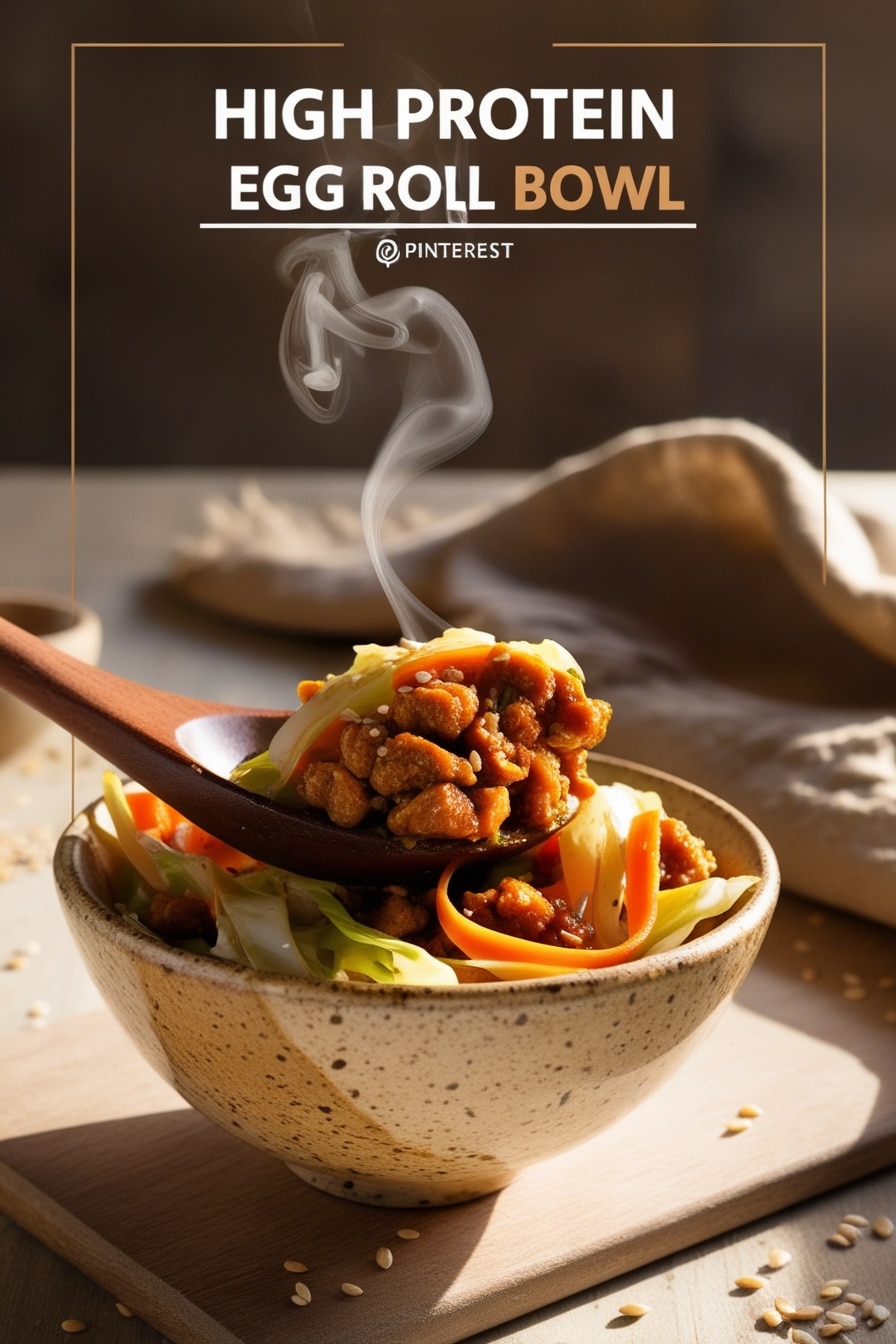Picture the crispy, savory filling of your fave takeout egg roll: lean ground meat, sweet and salty sauce, crunchy veggies, a tangle of flavor and heat. Now imagine ditching the wrapper, cranking up the protein, and tossing it all into one glorious skillet. That’s it. It’s fast, high-protein, low-carb without tasting like it’s punishing you. Even better, it respects your time—you can go from raw meat to steaming bowl in under 25 minutes if you hustle a bit.
But here’s what truly makes it special: that wild balance of textures. Tender ground chicken or turkey hugging sweet, crispy cabbage ribbons. Shiny threads of carrot. Green onions dropping sharpness at the end. And if you let the bottom catch just a smidge? You get caramelized, nutty bits that whisper “yes, chef” in your ear.
🥢 Ingredients & Substitutions
When it comes to building flavor fast, it ain’t just what you use, but why. I’ve laid them out by order of use so your mise en place won’t trip you.
| Ingredient | Why it matters | Substitutions / Variations |
|---|---|---|
| Ground chicken (lean, 93/7) | Mild flavor, high protein, quick cook | Ground turkey, pork, extra-firm crumbled tofu, tempeh for plant-based |
| Sesame oil (toasted) | Deep roasted aroma | Avocado oil + sprinkle of toasted sesame seeds |
| Garlic & fresh ginger | Brightness, warmth, base aroma | Garlic powder & ground ginger in a pinch (1:3 ratio) |
| Shredded green cabbage | Crunch, bulk, fiber | Napa cabbage, savoy, or bagged slaw mix |
| Shredded carrots | Sweetness & color | Zucchini matchsticks or bell pepper strips |
| Low-sodium soy sauce | Umami & salt | Tamari (GF), coconut aminos (paleo) |
| Rice vinegar | Balance & tang | Apple cider vinegar, white wine vinegar |
| Sriracha | Heat & subtle sweetness | Chili crisp, sambal oelek, or crushed red pepper |
| Green onions | Fresh pop at the end | Chives or cilantro |
| Optional toppings: sesame seeds, fried shallots, chili oil | Texture, depth, heat | Crushed peanuts, pickled jalapeños |
Fresh herbs beat dried every day of the week here—dry ginger tastes flat, like a forgotten spice rack jar. Fresh ginger? Bright and peppery, almost citrusy. Cabbage-wise, older leaves get bitter; use firm, tight heads. And ground chicken breast is fine, but thigh meat gives a juicier chew.
🔪 Step-by-Step Instructions
Keep the knife sharp and the pan hot—that’s half the magic. And don’t sweat if it ain’t photogenic halfway through. It comes together at the end.
1. Heat & Sizzle
In a large skillet or wok, drizzle 1 tablespoon toasted sesame oil over medium-high heat. Swirl until shimmering, then toss in garlic (3 cloves, minced) and fresh ginger (1 tablespoon, grated). Stir for 30 seconds. The kitchen should smell nutty and spicy—pull off heat if it starts smoking.
2. Brown the Protein
Add 1 pound of ground chicken. Break it up with a spatula. Let it sit undisturbed for a minute or two so it sears instead of steams. Stir again, cook until no pink remains (about 5–7 minutes).
Pro tip: high heat gives those caramelized, crispy edges. If the pan’s too crowded, split into batches.
3. Build the Bowl
Toss in 4 cups shredded cabbage and 1 cup shredded carrots. Stir-fry for about 3 minutes. You want the cabbage softened but still slightly crunchy, not sad and soggy.
4. Sauce & Balance
Pour in 3 tablespoons low-sodium soy sauce, 1 tablespoon rice vinegar, and 1–2 teaspoons sriracha (more if you love sweat-beading spice). Toss to coat everything. Taste and adjust—maybe a splash more vinegar if it’s flat, or soy sauce if bland.
5. Finish Fresh
Remove from heat. Stir in 2 sliced green onions. Scatter sesame seeds, chili oil, or fried shallots on top for drama and crunch.
Common rookie mistake? Overcooking cabbage until it goes gray and mushy. Or dumping all liquid at once—drizzle and toss instead. And yes, you can double the batch, but use a wider pan so you sear, not steam.
🔍 Cooking Techniques & Science
Ever wondered why high heat is gospel here? Heat caramelizes the sugars in cabbage and browns the meat, stacking umami and nutty notes. This Maillard reaction is why browned chicken tastes better than pale boiled bits.
Toasted sesame oil, added early, perfumes the meat. But if you finish with a raw drizzle at the end, the aroma blooms brighter—like perfume dabbed on your wrist.
Fermented sauces (soy, sriracha) add glutamates, natural umami bombs that trick your tongue into thinking “rich” and “satisfying” even in lean recipes.
Storage & Reheating
Cool leftovers quickly, transfer to airtight containers. Refrigerate up to 4 days. Reheat in a skillet over medium heat (best texture) or microwave (faster, slightly softer veggies). Splash a spoon of water or soy sauce to rehydrate if it feels dry.
Variations & Substitutions
- Vegan: Use crumbled extra-firm tofu or tempeh. Press tofu to remove moisture, then brown.
- Gluten-free: Swap soy sauce for tamari or coconut aminos.
- Extra spicy: Add gochujang or chili crisp.
- Keto: Skip carrots, add more cabbage or mushrooms.
Tools matter
A big, heavy skillet or carbon-steel wok holds heat better than nonstick pans. Sharp chef’s knife saves time (and knuckles). Microplane makes grating fresh ginger feel like zen art.
🍚 Serving & Pairing Suggestions
Serve it steaming hot in wide bowls. Top with extra green onions, sesame seeds, or a swirl of chili oil for color and kick.
Great beside steamed jasmine rice, cauliflower rice for low-carb days, or spooned over soba noodles. For crunch, pair with quick-pickled cucumbers. To drink? Iced green tea, cold lager, or a gingery kombucha.
Leftovers stuff nicely into lettuce wraps or rice paper rolls too—lunch hero move.
🕓 Best time to serve or eat this dish
Weeknights screaming for speed. Post-workout dinner (high-protein recovery). Meal prep Sundays—it reheats like a champ. Even brunch with a soft-fried egg on top. It’s humble but bends to your schedule.
✅ Conclusion: Why this recipe wins
So why does this humble, wrapper-less bowl steal hearts? It’s quick, high-protein, colorful, and hits that salty-sweet-spicy trifecta. The balance of crunch and tenderness keeps each bite alive.
Don’t sweat perfection—focus on hot pan, fresh ginger, don’t drown the veggies. Taste as you go. In under half an hour, you get comfort, nutrition, and a whisper of your favorite takeout, minus the deep fryer.
Final pro tips? Buy double the cabbage—it disappears faster than you’d guess. And toast sesame seeds yourself: 2 minutes in a dry pan brings out shocking flavor.
❓ FAQs
Q1: Can I freeze Egg Roll in a Bowl?
Yup, but texture softens. Cool completely, store in freezer bags up to 2 months. Thaw overnight, reheat gently.
Q2: How to make it lower sodium?
Use low-sodium soy sauce, skip extra salt, and watch toppings like fried shallots—they’re salt bombs.
Q3: What protein works best?
Lean ground chicken or turkey keeps it light. Pork brings juiciness. Tofu for plant-based. Just brown it well.
Q4: Can I meal prep this?
Absolutely. Makes 4 generous servings. Keeps 4 days, reheats quickly.
Q5: Do I need a wok?
Nope, a big heavy skillet works. Just avoid overcrowding so veggies sear, not steam.
And there you have it. A recipe born of a lazy night, saved by a hot pan and a hungry brain—and now, one of my go-tos to share with anyone who loves real food without real fuss. Go on, give it a whirl. Your taste buds (and macros) will thank ya.

